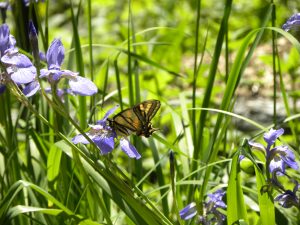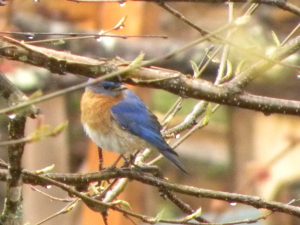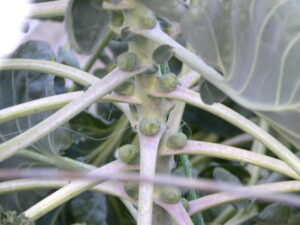In permaculture, we set aside some space to be wild and un-managed: zone 5. This is generally out beyond the domestic animals, gardens, and orchards, though it is not a hard boundary, and can be in more than one area. It’s a place to observe natural processes, add some diversity, and give that fair share to some non-human creatures.

Along with the deliberate cultivation of plants and animals that we do here, we deeply appreciate the wild creatures that we share the land with. One of the wonderful effects of our work here has been the increase in diversity we have seen. This land was all woods, mostly hemlock and some oak, birch, and maple up to 100 years old. It was lovely forest, but not very diverse.
As we’ve opened up around our house, taking out many trees, coppicing some, planting others, and planting a much larger variety of species, we have seen more and more birds. Our first year there were already pileated woodpeckers, phoebes, veerys and hummingbirds. After about a year of work we started to see goldfinches, nuthatches, chickadees, downy and hairy woodpeckers, and turkeys. We put up a bluebird box and that very season a pair nested and fledged a batch of babies!  The year after that, 2014, we had a scarlet tanager pair settle here. That was amazing and unexpected. We heard their song every day, and were lucky enough to watch them (through binoculars since they live way high up) teach their young ones flying and bug-catching skills.
The year after that, 2014, we had a scarlet tanager pair settle here. That was amazing and unexpected. We heard their song every day, and were lucky enough to watch them (through binoculars since they live way high up) teach their young ones flying and bug-catching skills.
Of course, a lot of hawks hang around our field, and would love to feast on our chickens, but our rooster is a good deterrent to their success with our livestock. We hope they are helping to keep our rodent population in check!

Since we started putting in ponds, we have lots of frogs, have seen spotted salamanders and red newts. Dragonflies hang out, hunting over the ponds and around my bee yard (less welcome, but the way of things!). Bats are also visible at dusk.
There are so many different insects, most of which are a mystery to me. Some we have identified are: pink maple moths, sphinx moths like little hummingbirds, swallowtail butterflies, carpenter bees, and metallic green sweat bees.
We have also seen various furry critters: weasels, porcupines, deer,  groundhogs, fox, red & gray squirrels, and, of course a million chipmunks stealing my strawberries. We know we have bear in our area and have to keep the bee yard well-electrified because of them.
groundhogs, fox, red & gray squirrels, and, of course a million chipmunks stealing my strawberries. We know we have bear in our area and have to keep the bee yard well-electrified because of them.
Some of these creatures are competing with us some for the harvests, but good fencing, growing enough to share and the rooster keep things in a balance we are usually happy with. Sometimes the ground hogs get the upper hand though, and that electric fence has got to be plugged in to work!! Then again, have you seen the African honey badger videos? We’ve got it easy here in NH, US!

